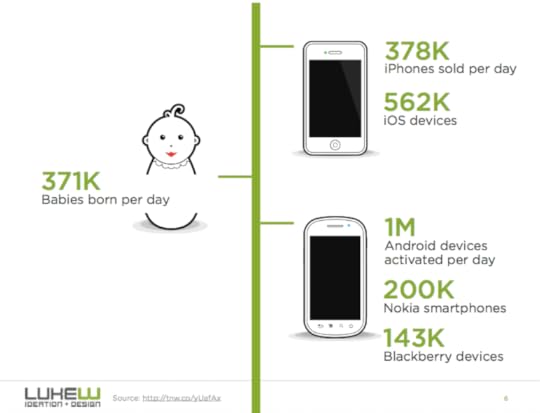Mobile to the Future
Notes on Luke Wroblewski’s “Mobile To The Future” presentation today at An Event Apart Austin:
First there was print, then recordings, then cinema, radio, TV, and the internet. Mobile is the seventh and latest form of mass media. And the smartphone is the fastest spreading technology in history. More iPhones are activated every day than babies are born.
Can mobile do what print did? What recordings did? What cinema did? What radio did? What TV and the internet did? Yes, mobile can do all of it. It also has unique properties: always with you, always on, built-in payment mechanism, at point of inspiration, accurate audience, captures social context, augmented reality, digital interface to reality.
When new mass media comes out, we try to apply old thinking to it. We treated early TV like radio (sponsors, jingles, spokesmen, programs). Radio shows migrated whole to early TV (Abbott & Costello, Lone Ranger, etc.) It took many years to realize that TV was not radio. Likewise, we still have ingrained print characteristics impacting how we think about web and mobile. (Page/canvas, grid layouts, typography, graphical ads.) As many people will tell you — but not many people practice — the web is not print.
Mobile is not desktop. “Copy, extend, and finally, discovery of a new form. It takes a while to shelf old paradigms.” – Scott Jensen
Companies are discovering they can do more on mobile. People are 2x more likely to buy on mobile; 2.5x more likely to subscribe; 3x more likely to be engaged. Don’t just look at the *constraints* of mobile; look at the opportunities.
Outline of remainder of talk: What we know from the desktop web; how to adapt and optimize for mobile; ways to move forward.
Consider login. People do at least 15 authentications per day. 82% of people have forgotten a site password. 5%-10% of people trying to access Yahoo fail to log in (and request password). The number one problem at help desks is, “Help, I forgot my password.” Login is a ubiquitous, but broken, system. We have brought all the problems of desktop login to the mobile platform, where problems are magnified. On Amazon, they removed “I forgot my user ID or password” from login to “save space” in mobile context. Result: 90% of their customer service calls were “I forgot my password.” Removing critical functionality is not a good way forward.
“Guest Checkout” is a popular feature on many commerce sites that increases conversion. You’d think this feature, which boosts conversions 30%, would be carried over to mobile. But Walmart.com omitted it. Instead they told the user to get a desktop computer.
“Mobile must never be a dumbed-down, limited experience,” says Steven Hoober.
Don’t remove critical features!
Do get rid of autocomplete and autocapitalize on login and password inputs.
Do use types (“type=password”) to facilitate sign-in.
Do show passwords; password masking results in login failures and lost opportunities.
Show passwords. (Give people the option to “Hide password” in case they need it.)
Use Input Masks on login, e.g. start “user name” fields with an “@” symbol. On MobileMe, there was an “@me.com” input mask in the user email address input screen (since you needed an @me.com address to be able to sign in anyway).
Quora doesn’t ask for your password immediately; first it checks to make sure you’ve entered your email address correctly.
One-tap operation: the second time you visit Quora, you can enter simply by tapping your avatar picture.
Third-party credentials (“sign in with Facebook”) cause problems, because users don’t remember if they created an account or signed in with Twitter/Facebook. Bagcheck and Votizen use a pattern where you begin typing your name and a series of selects show up, allowing you to pick your name from the list. Once it knows your name, the app gives you the chance to log in via your internal account or a third-party apps.””’
Summary so far
Don’t remove critical features.
Use input types and attributes.
Show password by default.
If possible, save people’s passwords so they can log in with one click.
Next time the user signs up, let them enter by tapping their avatar.
These techniques don’t just benefit mobile users. They also benefit those who use desktop, tablet, and God knows what’s coming next.




